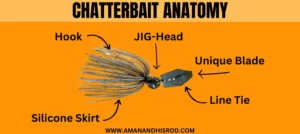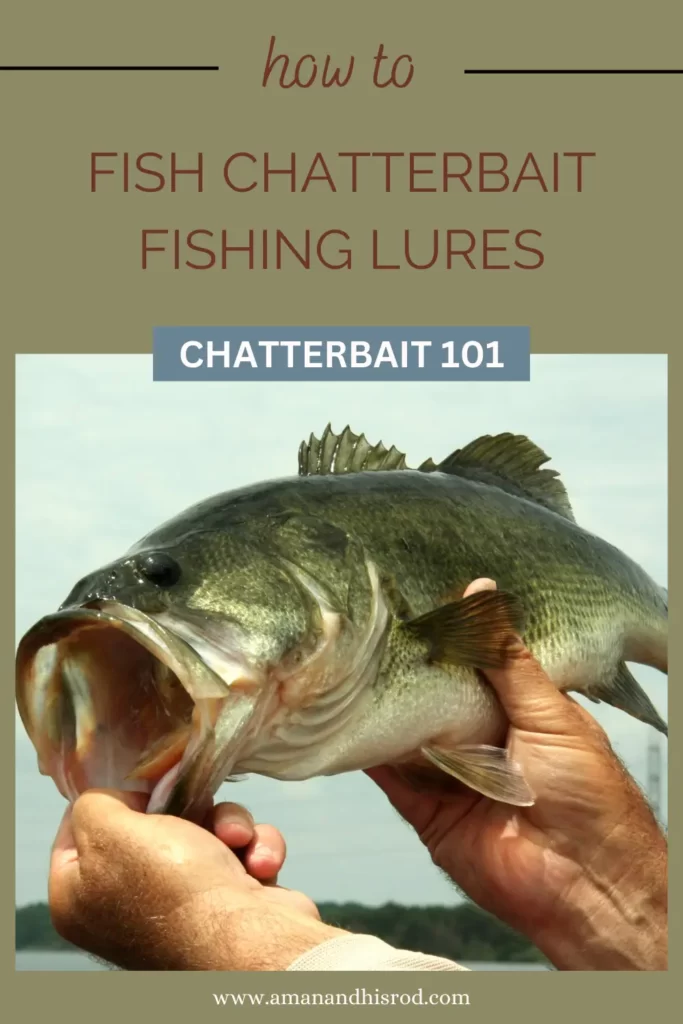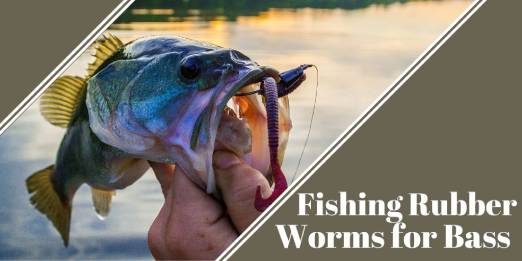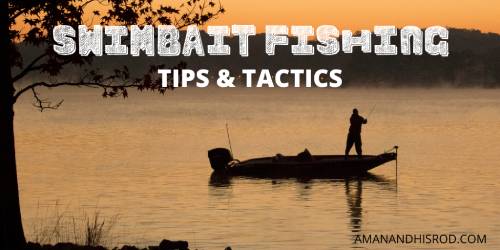On February 9, Brett Hite emerged victorious in an FLW Tour event at Lake Okeechobee. Out of the 20 bass he presented over the course of four days, nine were reeled in using a bladed jig, similar to the ChatterBait.
Chatterbait fishing lures starts its tale in the early 2000s when Ron Davis, a passionate fisherman, decided to disrupt the fishing scene by introducing this unique hybrid jig while bass fishing. His idea? To combine the attractive features of a spinnerbait and the subtlety of a jig into one potent fishing tool. Thus, chatterbait, also known as the bladed jig, was born.
Flash forward to today, chatterbaits have grown in popularity to become a must-have in every angler’s arsenal. Thanks to their distinctive vibrating action, they are incredibly effective at attracting fish, from bass to pike, in a variety of water conditions. But, what is it that makes this lure so irresistible to our finned friends? And how did it evolve from a fishing novelty to an essential staple in a sportsperson’s tackle box?
Stay with us as we delve deeper into the history and development of chatterbaits and explore their importance in today’s fishing culture.
What is a Chatterbait?
A chatterbait, known as a bladed jig in the angling world, is an ingenious hybrid lure that has revolutionized the fishing scene. But what makes this bait so compelling? Let’s dive into the details, explore its unique design features, and shed light on the variations you might encounter in the marketplace.

Detailed Description of Chatterbaits
A chatterbait consists of a lead jig head, a flat-bottomed blade (resembling a hexagonal shape), and a silicone skirt. The blade is attached to the jig head with a split ring or snap, creating an alluring chattering noise and erratic swimming action that fish find irresistible.
Explanation of the Unique Design and Features of Chatterbaits
The magic of a chatterbait lies in its unique design. Its distinctive hexagonal blade, located at the front of the lure, is what sets it apart from others. As the blade hits the water, it creates vibrations and a flashy appearance that mimics wounded prey, inciting predatory fish to strike. The silicone skirt adds to the illusion, fluttering and pulsating in the water, further tempting fish into biting.
Moreover, the versatility of chatterbaits is notable. They can be effectively used in various water conditions, depths, and fishing scenarios, whether it’s a cloudy day at a murky pond or a clear morning on a freshwater lake.
Different Types and Variations of Chatterbaits Available in the Market
Chatterbait fishing lures come in an array of types and variations, catering to different fishing conditions and species. You have the original Z-Man ChatterBait, renowned for its patented design and unmatched vibration. The ChatterBait Elite series incorporates a Gamakatsu hook for superior hooking efficiency. And the ChatterBait Freedom series, featuring an interchangeable hook design for greater customization.
Additionally, chatterbaits are available in various weights, colors, and skirt materials, allowing you to tailor your choice to the specific environment and target fish species. Whether you’re after a bass in a weed-lined lake or a pike in a fast-moving river, there’s a chatterbait designed to increase your chances of a successful catch.
Understanding the chatterbait, its unique design, and the variations available can up your game. Ready to explore further? Let’s continue our deep dive into the world of these incredible fishing lures!
How Do Chatterbait Fishing Lures Work?
Understanding the mechanisms behind the chatterbait can help unlock its full potential, revealing why this seemingly simple lure is such a game-changer in the angling community. From its unique vibrations to the science behind its alluring sound, let’s dissect how a chatterbait works.
Explanation of the Working Mechanism of Chatterbaits
The chatterbait’s effectiveness lies in its unique motion and sound. This action causes the entire lure to vibrate, creating a lively swimming motion that is hard for any predatory fish to ignore.
The silicone skirt attached to the jig head complements the blade’s action. As the chatterbait moves through the water, the skirt flutters and pulsates, further enhancing the lure’s mimicry of wounded prey. The result is an irresistible combination of visual and sensory stimuli that provoke predatory fish into striking.
The Science Behind the Vibration and Sound Made by Chatterbaits
While the chatterbait’s motion is critical, it’s the lure’s distinctive sound and vibration that truly set it apart. But what’s the science behind it?
In the underwater world, sound travels nearly five times faster than it does in air, making it a crucial communication and detection mechanism for aquatic creatures. Fish are extraordinarily sensitive to water vibrations, picking up on even the slightest disturbances through a specialized organ known as the lateral line.
When a chatterbait moves through the water, its wobbling blade generates vibrations and a distinct ‘chattering’ sound. This sound mimics the distress signals emitted by injured fish or the subtle flutter of a swimming crustacean – signals that resonate with predatory fish on a primal level. As a result, it’s the chatterbait’s unique capacity to exploit these sensory triggers that make it an excellent lure for a variety of fish species.
Thus, the chatterbait is not just another fishing lure; it is a perfect fusion of science, design, and angling intuition. This perfect design makes chatterbait fishing lures an optimal lure choice when bass fishing at night.
Why Use a Chatterbait
With a myriad of chatterbait fishing lures in the market, you might be wondering, “Why should I opt for a chatterbait?” The answer lies in the myriad benefits these lures provide, along with the unique features that set them apart from the rest. I personally use chatterbait fishing lures to find bass. They are ideal when used as a search bait. Let’s delve into why chatterbaits deserve a spot in your tackle box.

Benefits of Using Chatterbaits for Fishing
Chatterbaits offer a host of advantages that make them an excellent choice for both seasoned anglers and beginners alike. Here are a few benefits:
- Versatility: Chatterbaits are incredibly versatile. They can be used in diverse water conditions – murky or clear, shallow or deep, and are effective year-round, regardless of the weather.
- Species Attraction: They have a broad appeal to many species of fish, particularly predatory ones like bass, pike, and muskie. This lure’s vibrating action and enticing sound make it an irresistible target.
- Easy to Use: The chatterbait is a simple lure to use. A straight retrieve is often all that’s required to attract fish, making it ideal for both novice and experienced anglers.
- Customizable: Chatterbaits come in a variety of colors, sizes, and styles, allowing for significant customization to match your fishing conditions and targeted species.
Comparison of Chatterbaits with Other Types of Fishing Lures
When compared to other fishing lures, chatterbaits stand out because of their unique blend of attributes. Unlike standard jigs, chatterbaits produce an erratic swimming action and a chattering sound, which increase their allure to fish. Spinnerbaits, though similar in some ways, lack the subtlety of chatterbaits due to their typically larger size and overt motion.
Spinnerbaits for bass, while also designed to mimic prey, can’t match the chatterbait’s vibratory appeal or its effectiveness in varied water conditions. Lastly, unlike soft plastics that require more frequent replacement due to wear and tear, chatterbaits are more durable, often lasting many fishing trips without needing a replacement.
Chatterbaits are a fantastic addition to any angler’s toolkit. They offer a unique combination of benefits and stand out amongst other types of fishing lures due to their design, versatility, and effectiveness. Join us as we delve further into how to use this ingenious tool to bring your fishing game to the next level.
Choosing the Right Chatterbait
Picking the right chatterbait fishing lure can be a game-changer in your fishing experience. It’s not just about grabbing the first one off the shelf; there are several factors to consider to ensure you select the most effective chatterbait for your needs. Plus, we’ll explore the top brands and models that anglers worldwide are raving about.
Factors to Consider When Buying Chatterbait Fishing Lures
- Weight: The weight of a chatterbait affects its sink rate and retrieval speed. Lighter lures are ideal for shallow waters, while heavier ones are better for deeper water or fast current conditions.
- Color: The color choice should align with your fishing environment. In murky waters, bright, flashy colors are more visible. Conversely, in clear waters, more natural, subdued colors are effective.
- Blade Material and Color: The blade’s material can impact the vibration and flash produced by the chatterbait. For instance, stainless steel blades offer more vibration than plastic ones. Similarly, the color of the blade can influence visibility and attractiveness to fish.
- Hook Quality: A robust and sharp hook is crucial for a successful catch. Consider chatterbaits with high-quality hooks to ensure they can endure the fight when a fish bites.
- Skirt Material: A quality skirt adds to the lure’s appeal by creating a lifelike action in the water. Silicone skirts are often favored for their durability and pulsating action.

Top Chatterbait Brands and Models in the Market
- Z-Man Original ChatterBait: The pioneer of chatterbaits, Z-Man’s model is renowned for its patented design and unparalleled vibration.
- Strike King Rage Blade: This chatterbait stands out for the unique blade design that decreases the likelihood of snags, making it perfect for fishing in areas with heavy cover.
- Yamamoto Zako Chatterbait: A collaboration between Z-Man and Yamamoto, this chatterbait is famous for its irresistible skirt design and swim action.
Customer Reviews and Ratings of Popular Chatterbaits
Reviewing customer feedback is a valuable step when choosing a chatterbait. On platforms like Amazon, Bass Pro Shops, and Cabela’s, chatterbaits like Z-Man’s Original, Strike Kings Rage Blade, and Booyah Bymle Melee consistently score high ratings. Users often praise their effective vibration action, quality of construction, and versatility in attracting various fish species.
However, always consider your specific fishing conditions and needs when reviewing feedback. What works exceptionally for one angler might not suit your fishing style or target species.
In summary, selecting the right chatterbait requires a mix of understanding key features, knowing the top models, and considering feedback from fellow anglers. With this knowledge, you’re well on your way to making a choice that will up your fishing game. Stay tuned as we dive deeper into the art of using chatterbaits.
How to Fish a Chatterbait Fishing Lures for Bass
Using a chatterbait correctly is vital to make the most of its distinctive characteristics and to entice those elusive fish. Follow our step-by-step guide and consider our expert tips and tricks for an effective chatterbait fishing experience.
Step-by-step Guide on How to Use a Chatterbait for Fishing
- Rigging the Chatterbait: Attach the chatterbait to your fishing line. If necessary, you can add a trailer for added motion and attractiveness. Trailers can be anything from plastic worms to crawfish imitations.
- Casting: Cast your chatterbait toward your targeted area. This could be near structures where fish are likely to hide, such as weed lines, drop-offs, or around logs and rocks.
- Retrieving: Once your chatterbait hits the water, allow it to sink to your desired depth. Begin retrieving it with a steady reel-in. The lure will start to vibrate, creating the alluring “chatter.”
- Setting the Hook: When you feel a bite, swiftly but smoothly set the hook. This will ensure that the fish is securely hooked and ready for reeling in.
- Reeling In: Once the hook is set, begin to reel in your catch, maintaining a steady pressure to prevent the fish from getting away.
Tips and Tricks for Effective Use of Chatterbaits
- Vary Your Retrieve: Don’t stick to a uniform retrieval speed. Vary it and include occasional pauses. This mimics the erratic movement of injured prey, a potent trigger for predatory fish.
- Pair with the Right Rod: A medium-heavy rod with fast action is often ideal for chatterbait fishing. It provides the right balance of sensitivity to feel the bite and strength to set the hook.
- Use in the Right Conditions: Chatterbaits excel in stained or murky waters where their vibration and noise can attract fish better than visually oriented lures.
- Trailers are Your Friends: Don’t hesitate to use trailers to make your chatterbait more appealing. Soft plastic baits that mimic the fish’s natural prey work well.
- Work Around Structures: Chatterbaits are excellent for fishing around structures such as logs, rocks, or grass beds where fish often hide. Their design helps to prevent snags while providing an irresistible lure.
Incorporating these methods and tips into your fishing routine can significantly enhance your chatterbait experience. Stay with us for more in-depth insights into the fascinating world of chatterbaits.
Chatterbait Fishing Techniques
Fishing with chatterbaits is an art as much as it is a science, and understanding various techniques can drastically improve your success. From the way you handle the rod to how you present the lure, these strategies can shape your chatterbait fishing experience.
Different Techniques for Fishing with Chatterbaits
One of the most popular techniques for chatterbait fishing is the “straight retrieve.” This method is as simple as it sounds – cast your chatterbait out, let it sink to your desired depth, then reel it back in with a steady pace. The fluttering and vibrating action of the chatterbait during this retrieval often suffices to attract predatory fish.
The “yo-yo retrieve” is another tactic that can be particularly effective. With this method, you reel in the chatterbait for a few feet, then let it sink back down, repeating this process until your lure is back to you. This technique makes the lure appear as an easy meal, darting and sinking like a wounded fish.
Then there’s the “rip and fall” technique, which involves ripping the chatterbait through the water with a swift upward motion, then letting it fall back down. This abrupt, erratic action can trigger aggressive strikes from fish that might be following the lure without biting.
Expert Advice and Recommendations for Chatterbait Fishing
When it comes to chatterbait fishing lures, experts often emphasize the importance of paying attention to water conditions. In clearer water, a slower, more subtle retrieve might be beneficial, while faster, more aggressive retrievals could work better in stained or muddy waters.
Additionally, it’s crucial to match your chatterbait’s color and style to the type of prey the fish are feeding on in your specific fishing spot. For instance, if bass in the area is primarily eating bluegill, it may be advantageous to use a green pumpkin or blue chatterbait.
Lastly, don’t forget the impact of temperature on fish behavior. In colder waters, fish tend to be less aggressive and more lethargic. As such, a slower retrieve with plenty of pauses could yield better results. Conversely, in warmer waters, a faster, more continuous retrieve might be more enticing to active, feeding fish.
Fred Roumbanis, a professional bass fishing angler had this to say about fishing chatterbaits deep.
I was throwing it at the Mille Lacs [Toyota Bassmaster] Angler of the Year Championship, on the north end of the lake, with an Optimum AA shad as a trailer, and thought I was going to win,” Roumbanis said. “I was slow rolling it along bottom and catching an unbelievable size of fish. But the south wind got me, I got stubborn and never adjusted — probably because of how well I can catch them on this technique. And I used it, along with a big spoon, to finish fifth at Kentucky Lake in 2015 using an Optimum Victory Tail as the trailer.
Bassmaster.com – Article written by: Written by
Jon Storm
Understanding and applying these various techniques and expert tips can take your chatterbait fishing to new heights. Stay with us for even more insight and advice into mastering the art of chatterbait fishing.
Chatterbait Fishing Lures Concluded
Chatterbait fishing lures have revolutionized the world of fishing with their unique design, versatile use, and undeniable effectiveness. From their history and development to their mechanics, we’ve explored the reasons behind their popularity among the fishing community. We’ve also delved into the various factors to consider when choosing a chatterbait and discussed several techniques to ensure a successful fishing experience. This lure’s impressive versatility and ability to attract a wide range of fish species make it a worthy addition to any angler’s arsenal. Whether you’re a seasoned fisherman or a novice looking to make your mark, we hope this guide encourages you to incorporate chatterbaits into your fishing adventures. The water is calling, and a new experience awaits with every cast of a chatterbait.

